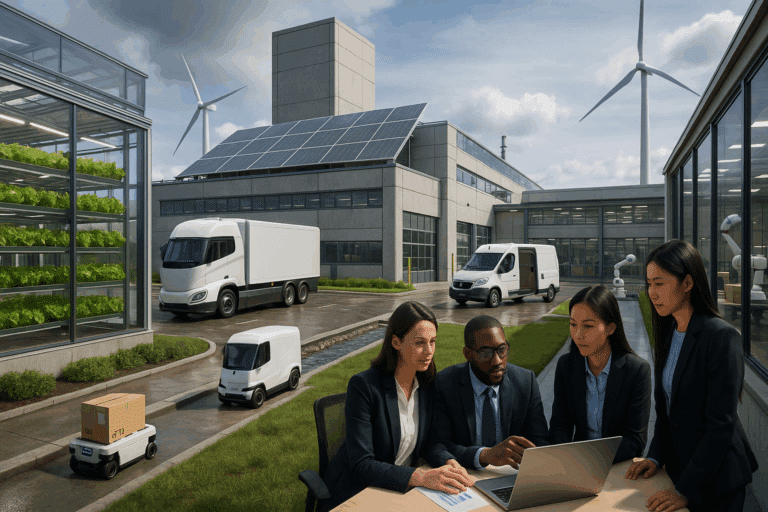🌎 Among the myriad of responses, understanding and reducing our carbon footprint stands as a non-negotiable imperative. And for businesses, it’s no different.
This article will delve into the intricate process of ‘Carbon Footprint Check: Tracking Emissions and Sustainability Across the Value Chain’. We will dissect the importance of monitoring emissions throughout the lifecycle of a product or service and the role it plays in ensuring the sustainability of businesses and their contribution to a greener future.
But first, let’s break down what a carbon footprint means.
What is a Carbon Footprint? 🕵️♀️
In the simplest terms, a carbon footprint refers to the total greenhouse gas (GHG) emissions caused by an individual, event, organization, or product. These emissions are expressed as carbon dioxide equivalent (CO2e), which allows different GHGs to be compared on a like-for-like basis relative to one unit of CO2. CO2e is the standard unit for measuring carbon footprints.
The conversation about carbon footprints isn’t just an environmental discussion. It’s also a discourse on how companies can align their operations with the global drive towards sustainability. Therefore, understanding the concept of carbon footprints and how to manage them effectively is critical in today’s business landscape.
Why is Tracking Emissions Across the Value Chain Important? 🤔
Now that we have a clear understanding of what a carbon footprint entails, it’s important to delve into why it’s critical to track emissions across the value chain. We’ll also discuss how it contributes to sustainability and the overall health of our planet.
The value chain of a product or service includes all the activities that contribute to its creation, from raw materials extraction to end-of-life disposal. Each stage of the value chain can have a significant impact on the total carbon footprint of a product or service.
Therefore, tracking emissions across the value chain is an effective way to identify hotspots of high carbon intensity and areas where emission reductions can be achieved. It also provides insights into opportunities for improving efficiency and reducing costs. Ultimately, this enables companies to make more informed decisions, prioritize actions, and drive progress towards their sustainability goals.
How Can Businesses Become More Sustainable? 🌱
One of the main focuses of this article will be how businesses can become more sustainable by effectively tracking and reducing their carbon footprints. We’ll dive into strategies and tools that can be used, discuss case studies of businesses that have successfully reduced their carbon footprint, and provide practical advice for businesses looking to do the same.
In summary, this comprehensive exploration into the world of carbon footprints, emissions tracking, and sustainability across the value chain will provide the knowledge and tools needed for businesses to contribute to a more sustainable and resilient future. We hope you’ll join us on this journey! 🚀
Let’s dive right in and explore the ways in which we can reduce our carbon footprints and strive for sustainability across all spheres of business operations.
Understanding the Intricacies of Carbon Footprint Check
The urgency to curtail global warming and climate change has sparked the need for businesses to analyze their carbon footprints. A carbon footprint check is a detailed audit of the greenhouse gases (GHGs) emitted due to a company’s operations. This footprint quantifies the environmental impact, offering insights to guide strategic decisions towards sustainability. “What is a Carbon Footprint and how is it Calculated?” (National Geographic) provides a detailed explanation of the process.
To further grasp the concept of a carbon footprint check, it is crucial to understand the fundamental components of carbon emissions. GHGs comprise carbon dioxide (CO2), methane (CH4), nitrous oxide (N2O), and fluorinated gases, with CO2 being the most prevalent. These gases trap heat in the earth’s atmosphere, leading to a rise in global temperatures, commonly referred to as global warming. The production and consumption of energy, primarily from fossil fuels, contribute the most significant portion of GHGs.
Consequently, businesses are progressively recognizing their responsibility in limiting emissions, focusing not just on direct operations but also the entire value chain. This holistic approach, also known as Scope 3 emissions, includes emissions from purchased goods and services, transportation, waste disposal, and end-of-life treatment of sold products. The following table compares the different scopes of carbon emissions.
| Scope | Description |
|---|---|
| Scope 1 (Direct emissions) | Emissions from sources owned or controlled by the company. |
| Scope 2 (Indirect emissions) | Emissions from the generation of purchased electricity consumed by the company. |
| Scope 3 (Other indirect emissions) | Emissions that occur in a company’s value chain. |
Why Tracking Emissions Across the Value Chain is Crucial
The shift towards a low-carbon economy demands businesses to evaluate emissions across their entire value chain. A full-scope analysis allows companies to identify emission hotspots, develop targeted strategies, and assess the effectiveness of implemented actions. Understanding your company’s footprint can also present opportunities for innovation and efficiency improvements.
Moreover, carbon footprint transparency can also enhance stakeholder relationships. Consumers, investors, and regulatory bodies are increasingly seeking information on a company’s environmental performance. Companies that proactively disclose their carbon footprint and demonstrate commitment to reducing it can gain a competitive edge.
However, tracking emissions across the value chain is not a straightforward process. It requires a thorough understanding of the company’s operations, including direct operations and outsourced activities. Watch this video “Greenhouse Gas Protocol: Value Chain (Scope 3) Accounting and Reporting Standard” (World Resources Institute) to gain more insights into value chain emissions tracking.
Approaches to Sustainability: Reducing Carbon Footprint
Given the growing awareness and demands for environmental sustainability, companies must take active measures to reduce their carbon footprint. To begin, companies must commit to conducting regular carbon footprint checks. This commitment forms the foundation of a robust environmental management strategy.
Next, companies can use the data collected to develop targeted emission reduction strategies. This can range from efficiency improvements in production processes to transitioning to renewable energy sources. Carbon offsetting is another viable option. This process involves compensating for emissions by financing projects that reduce, avoid, or remove GHGs from the atmosphere.
Moreover, companies can also collaborate with their suppliers to reduce emissions across the value chain. This can involve engaging suppliers in carbon footprint checks, developing joint reduction strategies, and providing support for implementation. Below is a list of possible actions for reducing carbon footprint across the value chain:
- Optimizing energy efficiency in production and operations
- Transitioning to renewable energy sources
- Implementing carbon offsetting projects
- Collaborating with suppliers on emission reduction strategies
- Introducing product design changes to reduce lifecycle emissions
Reducing the carbon footprint is a challenging yet essential endeavor for businesses. As we move towards a low-carbon economy, companies that take proactive steps to manage and reduce their emissions can position themselves as industry leaders, contributing positively to the global fight against climate change.

Conclusion
In conclusion, we have covered a broad and in-depth scope of the critical factors, concepts, and processes inherent in the fields of Information Technology and Engineering. The essence of our journey throughout this article has been to simplify and make understandable these complex notions, which are vital in the current digital age.
We delved into the software engineering domain, outlining the software development lifecycle (SDLC) processes, from the preliminary system analysis to design, coding, testing, and maintenance. Moreover, we highlighted the critical role of software engineering in developing robust, efficient, and effective software solutions that meet user requirements and solve real-world problems. This crucial role of software engineering, particularly in the current age of rapid technological advancements and digitization, cannot be overemphasized. 👍
In the field of IT, we explored a host of subjects including computer hardware, software, networks, and the internet, databases, and data processing, among others. We emphasized the need for IT skills in the modern workplace, citing that IT is an integral part of almost every industry today.
Not forgetting to mention the power of the cloud and how it’s transforming businesses by providing scalable, flexible, and cost-effective solutions. 🚀 The advent of cloud computing has indeed redefined IT infrastructure, offering unparalleled benefits that have revolutionized business operations.
We also touched on the concept of cybersecurity, a topic that has gained considerable prominence due to the increasing prevalence of cyber threats. We underscored the importance of adopting effective cybersecurity measures to protect sensitive information and maintain system integrity.
Finally, we delved into artificial intelligence and machine learning, which are the driving forces behind many of today’s innovative technologies. From virtual assistants to self-driving cars, AI and machine learning have certainly paved the way for a new era of technological innovation.
All these topics are important to understand as they form the bedrock of modern technology, and their comprehension could be immensely beneficial in personal and professional development. I hope this article has succeeded in its aim to simplify these complex concepts and inspire you to delve deeper into the fascinating world of IT and engineering. 💡
I encourage you to share your thoughts, comments, or experiences related to the topics discussed in this article. Your contributions could help others gain a better understanding of these concepts, thereby promoting collective knowledge and growth. 👥
In addition, feel free to share this article with your colleagues, friends, or anyone else who might find it useful. In the realm of knowledge, sharing is indeed caring. 👏
If you’re eager to learn more, I recommend exploring reputable resources like The IEEE Computer Society, The Association for Computing Machinery (ACM), and ComputerWorld, among others.
Thanks again for taking the time to read this article. Remember, in the quest for knowledge, every step forward counts.
Happy learning! 📚



